Volcanoes
Volcanoes come in all shapes and sizes. Although the name evokes images of the conical mountain spewing ash and lava, such events are rare, and are probably best seen on the TV news rather than witnessed up close in person. However, many volcanoes are tourist attractions, and are worth a visit.
- Not to be confused with Volcano, California.
Understand
According to the Smithsonian Global Volcanism Program, the major volcano monitoring organization based in Washington, DC, volcanoes can be classified as follows:
.jpg)
- active if it has erupted within the last 10,000 years (a short time in geological terms)
- dormant if it is active but not erupting
- extinct if it has not erupted for more than 10,000 years and does not show much activity such as hot springs, fumes, and earthquakes
Other organizations generally use the same terms, but may have somewhat different definitions. However the terms are defined, they are not precise; dormant volcanoes sometimes erupt, and it is not unknown for supposedly extinct volcanoes to come back to life.
There are hundreds of active volcanoes around the world, but many more that are dormant or extinct. One can still appreciate the awesome power of nature from these volcanoes, without the hazards that go with active ones.
There is a scale for the force of eruptions called the Volcanic Explosivity Index (VEI). The main (though not the only) factor is the volume of ejecta, the amount of material spewed out. The scale is mostly logarithmic; a VEI-5 eruption produces at least 1 km3 of ejecta, VEI-6 10 km3, VEI-7 100 km3, and VEI-8 1000 km3. The 20th century had seven eruptions of VEI-5 or VEI-6, and dozens at VEI-4, but none of VEI-7 or above.
Supervolcanoes are the largest volcanoes on Earth, but are not easily recognizable as such. Many are so big that, for many years, even geologists did not appreciate that these features were volcanoes in their own right. Compared to these, the active volcanoes on earth are relatively quite small! Supervolcanoes are generally in the form of large calderas, which are giant volcanic depressions formed either by large explosive eruptions or quiet long-term drainage of magma, and they often have associated lava flows or domes. Examples of supervolcanoes include Yellowstone in the United States, Toba in Indonesia, the Phelgraean Fields near Naples in Italy, and Taupo in New Zealand. Most supervolcanoes have undergone unimaginably huge eruptions (VEI-7 or 8) in the geologic past; these are what created the huge caldera. However, such eruptions are tens or hundreds of thousands of years apart. There is almost no reason to worry that Yellowstone, for example, will explode during your visit!
Really large eruptions are quite rare; the most recent VEI-8 event was over 26,000 years ago. The most recent VEI-7 events were Lake Taupo in 180 CE, maybe Lombok in 1257, and Mount Tambora in 1815. The Tambora eruption put out 160 cubic km (38 cubic miles) of ejecta, causing "the year without a summer", widespread crop failure and some famine as far away as the US and Europe. That was a relatively small eruption by supervolcano standards. Said "year without a summer" led the German Karl Drais to invent a "walking machine" which is today considered the first ancestor of the modern bicycle.
Some eruptions have complications. The 1883 eruption of Krakatoa was rated only 6 on the VEI scale, but the explosions were enormous — heard several thousand miles away and estimated to be equivalent to 200 megatons of TNT — partly because a huge amount of seawater was turned to steam on contact with hot magma.
Geothermal areas
Throughout volcanic areas of the world, one may also encounter geothermal areas. These places are often, but not always, associated with volcanic activity. Hot springs, geysers, mud pools and fumaroles (steam/gas vents) are common scenic features in geothermal areas, and hot springs can be great places to take a dip. Countries such as Japan and Iceland are especially famous for hot spring baths. Geothermal areas are also an environmentally friendly source of energy, and Iceland takes advantage of this very well.
Yellowstone National Park is probably the best known example of a geothermal area, as molten magma lies not far beneath its 640,000-year-old caldera. New Zealand, with its volcanoes in the North Island, is also known for extensive geothermal areas.
Preparations
Stay safe
- Main article: Volcano safety
Hazard zone
When you go near a volcano, especially if the volcano is active, you are entering a potentially dangerous area. Volcano hazard zones can extend for dozens of kilometers, and within these zones pyroclastic flows and volcanic bombs, rocks thrown upward by eruptions, are possible. Ashfall and volcanic mudflows, which are also hazards, can extend for hundreds of kilometers away from the volcano.
Eruptions
Volcanic bombs can be as big as a soccer ball; that is, large enough to be fatal. Pyroclastic flows, clouds of ash and debris, can rush downslope from their source vents, and the flows themselves can reach temperatures above 400°C (~750°F) and travel at 150 km/h (93 mph). Therefore, they can incinerate anything flammable within their path. Also, since volcanic ash stops vehicle engines, transportation near the pyroclastic flows can easily be disrupted. If a volcano is ice-covered, the ice will melt and cause floods. Hazardous areas may be evacuated and tourists should stay far away from the hazardous area. In most cases, you should stay as far away from hazardous areas as possible.
Dormant volcanoes
When a volcano is dormant, you can go fairly close to them and still be safe. But even dormant volcanoes are hazardous. Lava flows can still be hot for years after an eruption and only a thin crust of rock may be covering them. Old lava flows can be sharp as broken glass, so you need to wear hiking boots or very thick shoes. To add to these dangers, lethal gases may be seeping out of vents near the volcano.
Lahars are remnants of a previous eruption that are put into action again by other factors, like rainfall, an earthquake, or a collapsing crater lake. They can occur long after eruptions, and travel many kilometers and be devastating. While eruptions can give warning signs, lahars can have no warning. Watch out for possible lahars when there are heavy rains.
Geothermal areas
Geothermal areas can have hazards similar to those of volcanoes due to geological mechanisms. Hot springs and mud polls can be dangerous due to heat, acidity, or poison, so do not even go near these areas unless you know for sure that they are totally safe. Geysers are known for being in major geothermal areas, and they can erupt hot water or mud when not expected to do so. Landslides can be encountered in geothermal areas due to acidic fumes that seep out of gas vents or hot springs that weaken volcanic rock. Noxious gases can also be encountered coming out of holes in the ground, and the gases can reach dangerous levels in enclosed spaces like caves, manholes, or pool enclosures. Carbon dioxide, which is a byproduct of volcanic activity, is known for going into enclosed spaces and it can kill swiftly with little or no warning.
Active volcanoes
A selection of some of the more active and/or better known volcanoes in the world today. Some of these can still be explored from up close.
Africa
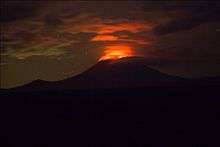
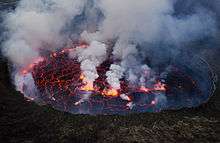
- Mount Cameroon The only volcano outside of Europe to have records of an eruption before the Common Era in 5 BC. It remains active today: its most recent eruption was in 2000.
- Kilimanjaro in Tanzania is Africa's tallest peak at 5895 m (19,340 ft). It has a series of concentric summit craters apparently less than 10,000 years old and may have last erupted less than 2000 years ago. The name Kilimanjaro means "shining mountain" in Swahili, no doubt due to the once-extensive glaciers which are unfortunately disappearing rapidly each year.
- Mount Nyiragongo in the far eastern D.R. Congo, near Goma and the Rwandan border. One of just four volcanoes in the world with a persistent lava lake, the others being Erta Ale (Ethiopia), Kilauea (Hawaii), and Mount Erebus (Antarctica). The volcano is usually accessed by overnight hike (8–10 hr up first day, hike down the following morning), with the night spent in tents on the rim of the caldera with stunning views of the lava lake and the surrounding region. Unfortunately, it is located in a conflict zone and access is occasionally blocked due to the presence of rebels & criminal gangs.
- Ol Doinyo Lengai ("Mountain of God" in the Masai tongue), in Tanzania, is the only volcano on Earth that erupts natrocarbonatite lava. This type of lava emerges black, cools to grey, and oxidizes to white.
Asia
India
- Barren Island is a volcanic island and the only active volcano in India. Day trips can be arranged from Port Blair. No additional permit is required to visit the island; however, it is not possible to set foot on the island, only to view it from the boat.
Indonesia
With 167 known active volcanoes, Indonesia is the world's most volcanic country by far.
- Krakatoa is an island in West Java province with several volcanoes on it which produced multiple explosions in 1883. The largest is estimated to have been equivalent to 200 megatons of TNT, about four times the largest H-bomb ever tested, and the sound was heard 5,000 km (3,100 mi) away. The dust cloud had worldwide effects; global temperatures dipped by over a degree. This was a VEI-6 event.
- Mount Batur in Bali is a very accessible active volcano which takes just 2 hours to climb.
- Mount Agung is a highly visible volcano in the interior of Bali. "Agung" means "great" in Indonesian. The volcano is considered quite sacred by Balinese people, and its slopes are home to the beautiful temple complex of Besakih. Its last eruption, in 1963, was quite devastating.
- Mount Bromo in East Java is known for its unreal scenery, especially with Mount Semeru, Indonesia's third highest active volcano nearby.
- Mount Merapi is perhaps Indonesia's single most active volcano (no mean feat). It looms large over the major cities of Yogyakarta and Solo, and the very popular temples of Borobudur and Prambanan. Merapi has erupted 68 times since formal record-keeping began in the 16th century. Its eruption on May 11, 2018, prompted the evacuation of areas within a 5-kilometre (3.1 mi) radius of the volcano, and the closure of the Yogyakarta airport.
- Mount Rinjani in Lombok is Indonesia's second highest volcano with a stunning crater lake. For much of 2009, the summit of the mountain was closed to the public due to eruptive activity.
- Mount Tambora in Sumbawa is one for the truly adventurous. Only about 50 visitors a year make it to this very remote volcano. In 1814 Tambora was 4,200 m (13,800 ft) high. It erupted with such force (VEI-7) the following year that 1,400 m (4,600 ft) was lost from its top. That was much the largest eruption in recent history, about ten times more powerful than the Krakatoa eruption a few decades later. It put enough dust and ash into the atmosphere to cause a "volcanic winter" that affected most of the Northern hemisphere; livestock deaths and crop failures caused the worst famine of the century.
Japan
- Mount Aso on the island of Kyushu in Japan, is one of the largest active volcanoes in the world with the largest caldera.
- Mount Fuji in central Japan near Tokyo, is Japan's highest and most beautiful volcano. It is also the most climbed mountain in the world because so many people climb it to view the sunrise from its summit crater.
Philippines
The Philippine Institute of Volcanology and Seismology lists 23 volcanoes as "active"; 21 of those have erupted in the last 600 years. Another 25 are listed as "potentially active" and 355 as "inactive".
- Mayon Volcano, near Legazpi City in the Philippines, described as the world's most perfect volcano cone. Mayon’s last fatal eruption was in 1993.
- Taal Volcano, in Batangas, a complex volcano system described as a "lake in a volcano in a lake" and one of the most picturesque landscapes in the Philippines, often seen from the nearby city of Tagaytay, where package tours to the volcano proper are offered. It is the Philippines's second most active volcano, with history of destructive eruptions and one of the "Decade Volcanoes".
Russia
- Kamchatka, Russia's largest Pacific peninsula, has several active volcanoes and some hot springs and geysers
Europe
Canary Islands
- El Teide in Tenerife, is the highest active volcano in the Canary Islands at 3715 m (12,188 ft). A flank vent at El Teide was observed erupting by Christopher Columbus and his crew in 1492.
Greece
- Nisyros in the Greek Dodecanese islands is mildly active with smoking fumaroles. It is possible to walk into the crater floor for a closer look.
- Santorini in the Aegean Sea, is probably Greece's most famous volcano because of its eruption that destroyed the Minoan civilization over 3,600 years ago. It is still active, for it last erupted in 1950 out of Nea Kameni ("New Burnt" in Greek), an island made up of lava flows in the middle of the caldera bay.
Iceland
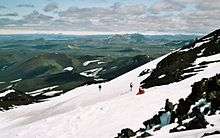
Iceland has many active volcanoes, among them Hekla, Katla and Askja. In medieval times Hekla was thought to be a gateway to Hell. It has had five eruptions since 1947 (the last being in 2000), and is regarded as unpredictable. The Eyjafjallajökull famously disrupted European air travel for days with an ash cloud released during an eruption in the year 2010.
Italy
- Vesuvius near Naples in Italy is a dormant volcano. It has not been smoking since it last erupted in 1944, but it is still very closely monitored because of its seriously hazardous proximity to Naples, which is southern Italy's largest city. This is the volcano that buried the Roman city of Pompeii in ash in 79 CE.
- Stromboli in the Aeolian Islands of Italy and Mount Etna in Sicily are two of Italy's most active volcanoes. At 3,350 m (10,990 ft), Etna is Europe's highest volcano. Stromboli has been in near continuous activity since at least the time of the Ancient Greeks and has been billed as the "Lighthouse of the Mediterranean".
North America and Caribbean
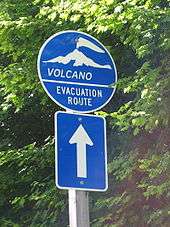
- The Aleutian Islands of Alaska are volcanic in origin and have several active volcanoes.
- Mount Baker in Washington State, USA, is one of the five major stratovolcanoes in the area that have produced over 200 eruptions in the last 12,000 years.
- Mount St. Helens, in Washington State, USA, is famous for its May 18, 1980 eruption. This was a VEI-5 event, one of the largest of the century. Since late 2004, it has been erupting once again, but not nearly as violently - this time, a new lava dome is slowly being extruded in its crater.
- Mount Hood, at a height of 11,239 ft (3,426 m) is the highest mountain in the state of Oregon and a major outdoor recreation site in the Pacific Northwest. Located about 50 mi (80 km) east-southeast of Portland, the mountain is visible from the city on clear days and usually forms the backdrop for the Portland skyline in postcards and photographs of the city.
- Mount Rainier, in Washington State, USA, at 14,410 ft (4,390 m), is the most prominent peak in the Cascade Range. The mountain stands nearly three miles higher than the lowlands to the west and one and one-half miles higher than the adjacent mountains. The volcano, which last erupted approximately 150 years ago, is encased in over 35 sq mi (91 km2) of snow and ice.
- Mount Redoubt, about 180 km (110 mi) southwest of Anchorage, is the largest active volcano in mainland Alaska.
- Popocatepetl, near Mexico City, often has a volcanic plume above its crater which is 5,450 m (17,880 ft) high. The name means "smoking mountain" in the native Nahuatl language.
- Saint-Pierre (Martinique) is a town that was wiped out by an eruption of Mount Pelée in 1902. Attractions today include a volcano museum and wreck diving around the many ships sunk by that eruption.
- Soufriere Hills volcano on Montserrat, previously considered dormant, began erupting again in 1995, forcing the closure of the southern half of the island (including its capital and airport in 1997). It is still active, though mostly a nuisance seeping lava and spewing ash into the air.
Canada has no active volcanoes and is thought to have had only about 50 eruptions in the past 10,000 years. However, the Canadian Rockies include many dormant volcanoes; geologically they are part of the same system that produces active volcanoes in Washington, Oregon and Alaska.
South and Central America
- Cotopaxi in Ecuador, often misstated as being the highest volcano in the world (despite its elevation of 5,911 m (19,393 ft), it does not even make the top ten list of highest active volcanoes - see this list here), is still one of South America's most spectacular volcanoes.
- Arenal in Costa Rica, the youngest volcano of the country. Its eruptions were frequent until 2010, but now it is calm.
- Volcan Santa Maria and Volcan Santiaguito in Guatemala, near Quetzaltenango.
- Volcan de Fuego and Volcan Pacaya in Guatemala, near Antigua Guatemala.
- Volcan Atitlan, Volcan San Pedro and Volcan Toliman in Guatemala, on the southern shores of Lake Atitlán.
- Volcan Láscar in the Atacama Region of northern Chile.
Oceania
Hawaii
- Kilauea in the Big Island of Hawaii, has been erupting continuously out of its flank vent, known as Pu'u O'o ("Hill of the O'o bird" in the native Hawai'ian language) since 1983.
- Mauna Loa, also in Hawaii, is the state's highest historically active volcano and is topped by the Moku'aweoeo Caldera. It is also the largest volcano by volume in the world. Don't be fooled by its gentle slopes - with its highest point at 4170m/13,683 ft), the altitude can be hard on inexperienced hikers and its summit is often covered in snow during the winter.
- Mauna Kea is the highest volcano in Hawaii at 4205 m (13,796 ft), and is pockmarked with cinder cones. Its high elevation is also a magnet for astronomers with their giant telescope facilities - and even skiers.
- Hale'akala ("House of the sun" in Hawai'ian), is the tallest volcano on the island of Maui, and is renowned for its erosional crater and the cinder cones nestled inside.
New Zealand
- Mount Ruapehu, Mount Tongariro and Mount Ngauruhoe in Tongariro National Park. Ruapehu, New Zealand's highest volcano, has a crater lake that forms and fills when the volcano is not erupting.
- White Island is a volcanic island in the Bay of Plenty, southeast of Auckland, and the most active volcano in New Zealand. Organized tours go to the island.
- The town of Taupo is located next to New Zealand's largest lake, which is the caldera of a supervolcano. It had a VEI-7 eruption in 180 CE that produced red skies as far away as Rome and China. Around 25,000 BCE it had a VEI-8 blast.
Papua New Guinea
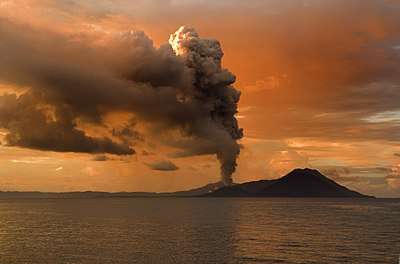
- Mount Tavurvur is a very active volcano right next to the city of Rabaul on the island of New Britain. It last erupted on 7 October 2006, shattering windows up to 12 km (7.5 mi) away and sending an ash plume 18,000 m (59,000 ft) into the stratosphere.
Travel agencies
The following travel agencies specialize in volcano tourism.
- Volcano Adventure Indonesia , Sukapura, Indonesia, tel. +62-335-581439, +62-81319090225, . Tours to Mount Bromo and elsewhere in Indonesia.
- VolcanoDiscovery, Germany, tel. +49 2241-2080175, +30 2107522310. This tour operator specializes in international volcanoes and one of its most important programs is for Indonesian volcanoes. The tours are trekking & photography tours with small groups and an intensive personal service. The tours are usually about 7–14 days.